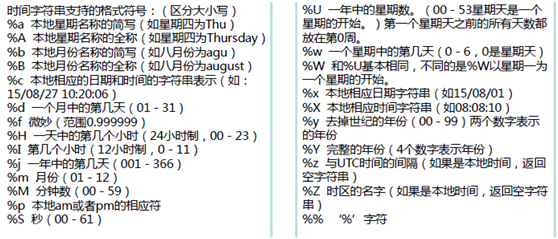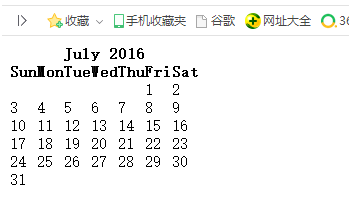时间 time
在Python中,与时间处理相关的模块有:time、datetime以及calendar。
学会计算时间,对程序的调优非常重要,可以在程序中狂打时间戳,来具体判断程序中哪一块耗时最多,从而找到程序调优的重心处。
在Python中,通常有这几种方式表示时间:时间戳、格式化的时间字符串、元组(struct_time 共九种元素)。由于Python的time模块主要是调用C库实现的,所以在不同的平台可能会有所不同。
时间戳(timestamp)的方式:时间戳表示是从1970年1月1号 00:00:00开始到现在按秒计算的偏移量。Tick单位(时间间隔以秒为单位的浮点小数)最适于做日期运算。但是1970年之前的日期就无法以此表示了。太遥远的日期也不行,UNIX和Windows只支持到2038年某日。查看一下type(time.time())的返回值类型,可以看出是float类型。返回时间戳的函数主要有time()、clock()等。
UTC(世界协调时),就是格林威治天文时间,也是世界标准时间。在中国为UTC+8。DST夏令时。
元组方式:struct_time元组共有9个元素,返回struct_time的函数主要有gmtime(),localtime(),strptime()。
时区(Time Zone)是地球上的区域使用同一个时间定义。1884年在华盛顿召开国际经度会议时,为了克服时间上的混乱,规定将全球划分为24个时区。
time.localtime()时间元祖:
>>> import time
>>> time.localtime()
time.struct_time(tm_year=2018, tm_mon=1, tm_mday=30, tm_hour=22, tm_min=41, tm_sec=56, tm_wday=1, tm_yday=30, tm_isdst=0)

既然是一个元组,那么就遵循元组的所有特性,比如索引(都从0开始),切片等。下面是元组中各元素的解释:
tm_year:年
tm_mon:月(1-12)
tm_mday:日(1-31)
tm_hour:时(0-23)
tm_min:分(0-59)
tm_sec:秒(0-59)
tm_wday:星期几(0-6,6表示周日)
tm_yday:一年中的第几天(1-366)
tm_isdst:是否是夏令时(默认为-1)
>>>t=time.localtime()
>>> t
time.struct_time(tm_year=2018, tm_mon=1, tm_mday=30, tm_hour=22, tm_min=47, tm_sec=45, tm_wday=1, tm_yday=30, tm_isdst=0)
>>> dir(t)
['__add__', '__class__', '__contains__', '__delattr__', '__doc__', '__eq__', '__format__', '__ge__', '__getattribute__', '__getitem__', '__getslice__', '__gt__', '__hash__', '__init__', '__le__', '__len__', '__lt__', '__mul__', '__ne__', '__new__', '__reduce__', '__reduce_ex__', '__repr__', '__rmul__', '__setattr__', '__sizeof__', '__str__', '__subclasshook__', 'n_fields', 'n_sequence_fields', 'n_unnamed_fields', 'tm_hour', 'tm_isdst', 'tm_mday', 'tm_min', 'tm_mon', 'tm_sec', 'tm_wday', 'tm_yday', 'tm_year']
>>>
由上可见,localtime()是有一些内置属性的,类似于string的letters一样,可以用t.tm_mday来方位tm_mday这个属性的值
练习定义两个函数,返回年月日,时分秒
#encoding=utf-8
def get_day():
import time
time_t=time.localtime()
return u"现在是%s年%s月%s日" %(time_t.tm_year,time_t.tm_mon,time_t.tm_mday)
print get_day()
def get_sec():
import time
time_t=time.localtime()
return u"现在是%s时%s分%s秒" %(time_t.tm_hour,time_t.tm_min,time_t.tm_sec)
print get_sec()
c:Python27Scripts>python task_test.py
现在是2018年1月30日
现在是22时57分46秒
Time.localtime()可以用下标取值
>>> import time
>>> time.localtime()
time.struct_time(tm_year=2018, tm_mon=1, tm_mday=31, tm_hour=23, tm_min=9, tm_sec=34, tm_wday=2, tm_yday=31, tm_isdst=0)
>>> time.localtime()[0]
2018
>>> time.localtime()[1]
1
>>> time.localtime()[2]
31
>>>
格林威治时间,英国
>>> time.gmtime()
time.struct_time(tm_year=2018, tm_mon=1, tm_mday=31, tm_hour=15, tm_min=10, tm_sec=0, tm_wday=2, tm_yday=31, tm_isdst=0)
时间戳time.time()
>>> time.time()
1517411441.422
时间戳取整,用int或者用%.f小数点位数
>>> time.time()
1517411441.422
>>> type(time.time())
<type 'float'>
>>> int(time.time())
1517411467
>>> "%.f"%time.time()
'1517411621'
>>> "%.1f"%time.time()
'1517411632.6'
>>> "%.2f"%time.time()
'1517411635.87'
用时间戳通过localtime()生成时间
>>> time.localtime(1517411635.87)
time.struct_time(tm_year=2018, tm_mon=1, tm_mday=31, tm_hour=23, tm_min=13, tm_sec=55, tm_wday=2, tm_yday=31, tm_isdst=0)
练习:实现函数转换时间戳到时间
#encoding=utf-8
#encoding=utf-8
import time
def get_year_mon_day(timestamp=None):
if timestamp ==None:
time_array=time.localtime()
else:
try:
time_array=time.localtime(timestamp)
except:
print "time convert error occur!"
return None
return u"%s年%s月%s日" % (time_array.tm_year,time_array.tm_mon,time_array.tm_mday)
print get_year_mon_day(1517411635.87)
print get_year_mon_day()
def get_hour_min_sec(timestamp=None):
if timestamp ==None:
time_array=time.localtime()
else:
try:
time_array=time.localtime(timestamp)
except:
print "time convert error occur!"
return None
return u"%s时%s分%s秒" %(time_array.tm_hour,time_array.tm_min,time_array.tm_sec)
print get_hour_min_sec(1517411635.8)
print get_hour_min_sec()
c:Python27Scripts>python task_test.py
2018年1月31日
2018年1月31日
23时13分55秒
23时29分53秒
Time.mktime()将时间元祖转换到时间戳
>>> time_array=time.localtime()
>>> time_array
time.struct_time(tm_year=2018, tm_mon=1, tm_mday=31, tm_hour=23, tm_min=31, tm_sec=3, tm_wday=2, tm_yday=31, tm_isdst=0)
>>> time.mktime(time_array)
1517412663.0
>>> time.mktime(time_array)
1517412663.0
Time.gmtime()将时间戳转为UTC时间
>>> time.time()
1517412894.745
>>> time.gmtime(1517412894.745)
time.struct_time(tm_year=2018, tm_mon=1, tm_mday=31, tm_hour=15, tm_min=34, tm_sec=54, tm_wday=2, tm_yday=31, tm_isdst=0)
Time.sleep()睡眠
Time. clock()CPU的累计时间,不同时间的time.clock()相减计算时间差
>>> import time
>>> time.clock()
19.208307247590035
>>> time.clock()
20.248680169227494
>>> time.clock()
20.712062032827205
格式化时间字符串time.strftime,time的常用函数—strftime
返回字符串表示的当地时间
把一个代表时间的元组或者struct_time(如由time.localtime()和time.gmtime()返回)转化为格式化的时间字符串,格式由参数format决定。如果未指定,将传入time.localtime()。如果元组中任何一个元素越界,就会抛出ValueError的异常。函数返回的是一个可读表示的本地时间的字符串。
参数:
format:格式化字符串
t :可选的参数是一个struct_time对象

>>> strTime=time.strftime("%Y-%m-%d-%H:%M:%S",time.localtime())
>>> strTime
'2018-02-01-20:15:50'
>>> print time.strftime("%Y-%m-%d-%a:%M:%b:%c",time.localtime())
2018-02-01-Thu:17:Feb:02/01/18 20:17:17
>>> print time.strftime("%Y-%m-%d-%a:%M:%b:%c",time.localtime())
2018-02-01-Thu:17:Feb:02/01/18 20:17:17
>>> print time.strftime("%S",time.localtime())
53
>>> print time.strftime("%X",time.localtime())
20:17:57
>>> print time.strftime("%X-%xx",time.localtime())
20:18:02-02/01/18x
>>> print time.strftime("%X-%x",time.localtime())
20:18:08-02/01/18
>>> print time.strftime("%X-%x-%y-%Y-%z-%Z",time.localtime())
20:18:36-02/01/18-18-2018-中国标准时间-中国标准时间
>>> print time.strftime("%X-%x-%y-%Y-%z-%Z-%z-%Z",time.localtime())
20:19:01-02/01/18-18-2018-中国标准时间-中国标准时间-中国标准时间-中国标准时间
>>>
>>> print time.strftime("%Y/%m/%d %H:%M:%S",time.localtime())
2018/02/01 20:20:24
>>> print time.strftime("%Y年/%m/%d %H:%M:%S",time.localtime())
2018年/02/01 20:20:39
>>> print time.strftime("%Y年/%m分/%d秒 %H:%M:%S",time.localtime())
2018年/02分/01秒 20:20:56
>>> print time.strftime("%Y年/%m月/%d日 %H:%M:%S",time.localtime())
2018年/02月/01日 20:21:08
练习,在文件模式下中文显示时间
#encoding=utf-8
import time
print time.strftime("%Y年%m月%d日-%H:%M:%S",time.localtime()).decode('utf-8')
print type(time.strftime("%Y年%m月%d日-%H:%M:%S",time.localtime()).decode('utf-8'))
c:Python27Scripts>python task_test.py
2018年02月01日-20:32:07
<type 'unicode'>
time.strptime把具体的时间字符串转换为时间元祖
将格式字符串转化成struct_time.
该函数是time.strftime()函数的逆操作。time strptime() 函数根据指定的格式把一个时间字符串解析为时间元组。所以函数返回的是struct_time对象。
参数:
string :时间字符串
format:格式化字符串
>>> stime="2015-08-24 13:01:30"
>>> print time.strptime(stime,"%Y-%m-%d %H:%M:%S")
time.struct_time(tm_year=2015, tm_mon=8, tm_mday=24, tm_hour=13, tm_min=1, tm_sec=30, tm_wday=0, tm_yday=236, tm_isdst=-1)
>>> format_time=time.strptime(stime,"%Y-%m-%d %H:%M:%S")
>>> format_time
time.struct_time(tm_year=2015, tm_mon=8, tm_mday=24, tm_hour=13, tm_min=1, tm_sec=30, tm_wday=0, tm_yday=236, tm_isdst=-1)
>>> for i in format_time:
... print i
...
2015
8
24
13
1
30
0
236
-1
注意在使用strptime()函数将一个指定格式的时间字符串转化成元组时,参数format的格式必须和string的格式保持一致,如果string中日期间使用“-”分隔,format中也必须使用“-”分隔,时间中使用冒号“:”分隔,后面也必须使用冒号分隔,否则会报格式不匹配的错误
>>> time.strptime("2018-02-01 20:42:14","%Y-%m-%d %H:%M:%S")
time.struct_time(tm_year=2018, tm_mon=2, tm_mday=1, tm_hour=20, tm_min=42, tm_sec=14, tm_wday=3, tm_yday=32, tm_isdst=-1)
下面因为后面的格式匹配,报错
>>> time.strptime("2018-02-01 20:42:14","%Y-%m-%d %H:%M:%S")
time.struct_time(tm_year=2018, tm_mon=2, tm_mday=1, tm_hour=20, tm_min=42, tm_sec=14, tm_wday=3, tm_yday=32, tm_isdst=-1)
>>> time.strptime("2018-02-01 20:42:14","%Y-%m-%d %H:%M:%X")
Traceback (most recent call last):
File "<stdin>", line 1, in <module>
File "C:Python27lib\_strptime.py", line 478, in _strptime_time
return _strptime(data_string, format)[0]
File "C:Python27lib\_strptime.py", line 315, in _strptime
format_regex = _TimeRE_cache.compile(format)
File "C:Python27lib\_strptime.py", line 269, in compile
return re_compile(self.pattern(format), IGNORECASE)
File "C:Python27lib e.py", line 194, in compile
return _compile(pattern, flags)
File "C:Python27lib e.py", line 251, in _compile
raise error, v # invalid expression
sre_constants.error: redefinition of group name 'H' as group 6; was group 4
>>> time.strptime("2018-02-01 20:42:14","%Y-%m-%d %H:%M:%X")
Traceback (most recent call last):
File "<stdin>", line 1, in <module>
File "C:Python27lib\_strptime.py", line 478, in _strptime_time
return _strptime(data_string, format)[0]
File "C:Python27lib\_strptime.py", line 315, in _strptime
format_regex = _TimeRE_cache.compile(format)
File "C:Python27lib\_strptime.py", line 269, in compile
return re_compile(self.pattern(format), IGNORECASE)
File "C:Python27lib e.py", line 194, in compile
return _compile(pattern, flags)
File "C:Python27lib e.py", line 251, in _compile
raise error, v # invalid expression
sre_constants.error: redefinition of group name 'H' as group 6; was group 4
>>> time.strptime("2018-02-01 20:42:14","%Y-%m-%d %H:%M:%S")
>>> time.strptime(stime,"%Y-%m-%d %H:%M:%S")
time.struct_time(tm_year=2018, tm_mon=2, tm_mday=1, tm_hour=20, tm_min=42, tm_sec=14, tm_wday=3, tm_yday=32, tm_isdst=-1)
Python datetime模块详解
datetime模块是Python中另一个用于操作时间的内置模块,是基于time包的一个高级包。相比于time模块,datetime模块的接口更直观、更容易调用。datetime可以理解为date和time两个部分组成,date是指年月日构成的日期(相当于日历),time是指时分秒微妙构成的一天24小时中的具体时间(相当于手表)。由此可以将这两个分开管理(datetime.date类,datetime.time类),也可以将两者合并在一起(datetime.datetime类)。下面就分别介绍一下datetime模块中的这几个类。 引入datetime模块: import datetime(或 from datetime import *) datetime模块定义了两个常量: datetime.MINYEAR :最小年份,MINYEAR = 1。 datetime.MAXYEAR:最大年份。MAXYEAR = 9999。 datetime模块定义了下面几个类: datetime.date:日期类。常用的属性有year,month,day; datetime.time:时间类。常用的属性有hour,minute,second,microsecond; datetime.timedalta:表示时间间隔,即两个时间点之间的长度。 datetime.tzinfo:与时区有关的信息。 以上这些类都是datetime模块中的类,但是需要注意的是这些类中的对象都是不可被改变的。下面来具体讲解一下这些类的使用方法。
Datetime.date.today()
>>> print datetime.date.today()
2018-02-01
通过时间戳转换为当前的年月日
>>> import time
>>> import datetime
#获取当前时间的时间戳
>>> now=time.time()
>>> now
1517489601.47
#将时间戳转换为date类型的时间
>>> s=datetime.date.fromtimestamp(now)
>>> s
datetime.date(2018, 2, 1)
>>> print s
2018-02-01
date的常用函数—date.weekday函数
返回weekday中的星期几,星期一,返回0;星期二,返回1;以此类推。
该函数需要一个datetime.date类型的参数。
>>> import datetime
>>> now=datetime.date.today()
>>> print now
2018-02-02
>>> print datetime.date.weekday(now)
4
now.strftime()转化成指定格式的年月日
>>> import datetime
>>> now=datetime.datetime.now()
>>> print now
2018-02-02 21:40:20.250000
>>> otherStyleTime=now.strftime("%Y-%m-%d %H:%M:%S")
>>> print otherStyleTime
2018-02-02 21:40:20
timedelta,基于年月日算时间差时间加上时间间隔
>>> from datetime import *
>>> today=date.today()#获取今天的日期
>>> print today
2018-02-02
#在今天的日期上再加上10天
>>> print today+timedelta(days=10)
2018-02-12
#encoding=utf-8
from datetime import *
#获取今天的日期
today=date.today()
print today
#在今天的日期上减去10天
print today-timedelta(days=10)
c:Python27Scripts>python task_test.py
2018-02-02
2018-01-23
两个日期相减算时间差
#encoding=utf-8
from datetime import *
#获取今天的日期
today=date.today()
print today
#替换形成一个新的日期
future=today.replace(day=15)
print future
#算一个两日相隔的间隔
delta=future-today
print delta
#在原日期上添加一个日期间隔
print future+delta
c:Python27Scripts>python task_test.py
2018-02-02
2018-02-15
13 days, 0:00:00
2018-02-28
只取相差天数
#encoding=utf-8
from datetime import *
#获取今天的日期
today=date.today()
print today
#替换形成一个新的日期
future=today.replace(day=15)
print future
#算一个两日相隔的间隔
delta=future-today
print str(delta)
print str(delta).split()
print str(delta).split()[0]
#在原日期上添加一个日期间隔
print future+delta
c:Python27Scripts>python task_test.py
2018-02-02
2018-02-15
13 days, 0:00:00
['13', 'days,', '0:00:00']
13
2018-02-28
比较时间大小
#encoding=utf-8
from datetime import *
#今天的日期
now=date.today()
print now
#未来的日期
tomorrow=now.replace(day=13)
print tomorrow
#比较两日期大小
print tomorrow > now
time类
#coding=utf-8
from datetime import *
#tm=time(23,46,10
tm=datetime.now()
print tm
print tm.hour
print tm.minute
print tm.second
print tm.microsecond
c:Python27Scripts>python task_test.py
2018-02-02 22:25:54.539000
22
25
54
539000
>>> from datetime import *
>>> tm=datetime.now()
>>> print tm
2018-02-02 22:27:45.876000
>>> print tm.year
2018
>>> print tm.month
2
>>> print tm.day
2
>>> print tm.hour
22
>>> print tm.second
45
>>> print tm.minute
27
>>> print tm.microsecond
876000
datetime.now()
>>> import time
>>> from datetime import *
>>> datetime.now
<built-in method now of type object at 0x000000006B870340>
>>> datetime.now()
datetime.datetime(2018, 2, 2, 22, 29, 12, 628000)
>>>
replace()时间替换
>>> from datetime import *
>>> tm=datetime.now()
>>> print tm
2018-02-02 22:29:55.649000
>>> tm1=tm.replace(hour=12,minute=10,second=10)
>>> print tm1
2018-02-02 12:10:10.649000
>>>
tm=time(23, 46, 10)=> 23:46:10用time()可以指定时分秒
tm.strftime("%H-%M-%S")strftime()对具体时间进行格式化
>>> from datetime import *
>>> tm=time(23,46,10)
>>> print tm
23:46:10
>>> tm1=tm.strftime("%H-%M-%S")
>>> print tm1
23-46-10
>>>
Datetime.strptime()将格式时间字符串转换为datetime对象
>>> stime=datetime.datetime.strptime("2015-08-27 17:23:43","%Y-%m-%d %H:%M:%S")
>>> stime
datetime.datetime(2015, 8, 27, 17, 23, 43)
>>> type(stime)
<type 'datetime.datetime'>
>>> stime.day
27
>>> stime.year
2015
>>> stime.second
43
>>> import datetime
>>> print datetime.datetime.strptime("2015-08-27 17:23:43","%Y-%m-%d %H:%M:%S")
2015-08-27 17:23:43
times.replace(year = 2017, hour = 23)
#coding=utf-8
import datetime
times=datetime.datetime.today()
print times
#替换原有时间,获得新的日期时间
tmp=times.replace(year=2017,hour=23)
print tmp
c:Python27Scripts>python task_test.py
2018-02-02 22:45:41.797000
2017-02-02 23:45:41.797000
将datetime对象转换成时间戳
#coding=utf-8
import datetime
import time
#获取当前时间的datetime对象
t=datetime.datetime.now()
print t
#根据当前时间的datetime对象获取当前时间的时间元祖
struct_time=t.timetuple()
print struct_time
#根据当前时间的时间元祖获得当前时间的时间戳
timeStamp=time.mktime(struct_time)
#对时间戳取整
timeStamp=int(timeStamp)
print timestamp
c:Python27Scripts>python task_test.py
2018-02-02 22:53:53.935000
time.struct_time(tm_year=2018, tm_mon=2, tm_mday=2, tm_hour=22, tm_min=53, tm_sec=53, tm_wday=4, tm_yday=33, tm_isdst=-1)
1517583233
Datetime对象通过timetuple()函数转换到时间元祖
>>> datetime.datetime.today()
datetime.datetime(2018, 2, 2, 22, 50, 13, 600000)
>>> datetime.datetime.today().timetuple()
time.struct_time(tm_year=2018, tm_mon=2, tm_mday=2, tm_hour=22, tm_min=50, tm_sec=26, tm_wday=4, tm_yday=33, tm_isdst=-1)
>>> print datetime.datetime.today()
2018-02-02 22:50:36.262000
>>>
求天数差
>>> import datetime
>>> d1=datetime.datetime(2015,7,5)
>>> d2=datetime.datetime(2015,8,26)
>>> print d1
2015-07-05 00:00:00
>>> print d2
2015-08-26 00:00:00
>>> print d2-d1
52 days, 0:00:00
>>> print (d2-d1).days
52
>>> print (d2-d1).seconds
0
datetime.datetime(2015,7,5)= 2015-07-05 00:00:00
timedelta类
>>> import datetime
>>> print datetime.timedelta(days=1)
1 day, 0:00:00
#coding=utf-8
import datetime
import time
#获取当前的时间
now = datetime.datetime.now()
print now
#设定一个时间间隔,间隔为1天
delta=datetime.timedelta(days=1)
newTime=now+delta
print newTime
#得到明天的时间
print str(newTime)[:-7]
#或者使用格式化函数
print newTime.strftime("%Y-%m-%d %H:%M:%S")
#原时间减一天
delta=datetime.timedelta(days=-1)
newTime=now+delta
print newTime
c:Python27Scripts>python task_test.py
2018-02-02 23:09:27.367000
2018-02-03 23:09:27.367000
2018-02-03 23:09:27
2018-02-03 23:09:27
2018-02-01 23:09:27.367000
算100天前的日期
#coding=utf-8
from datetime import datetime
from datetime import timedelta
now = datetime.now()
#设置100天前的时间间隔
delta = timedelta(days = -100)
#得到100天前的时间
oldTime = now + delta
print oldTime.strftime("%Y-%m-%d")
c:Python27Scripts>python task_test.py
2017-10-25
按小时算小时的时间差
#coding=utf-8
import datetime
threeHoursAgo = datetime.datetime.now() - datetime.timedelta(hours = 3)
print datetime.datetime.now()
print str(threeHoursAgo)[:-7]
c:Python27Scripts>python task_test.py
2018-02-02 23:14:45.110000
2018-02-02 20:14:45
计算给定时间间隔的总秒数
#coding=utf-8
import datetime
#计算给定时间间隔的总秒数
seconds = datetime.timedelta(hours=1, seconds=30).total_seconds()
print seconds
c:Python27Scripts>python task_test.py
3630.0
calendar日历
calendar.isleap(2015) 判断是否是闰年
import calendar
#判断2015年是否是闰年
if calendar.isleap(2015) is True :
print u"2015年是闰年"
else :
print u"2015年不是闰年"
c:Python27Scripts>python task_test.py
2015年不是闰年
打印日历
#coding=utf-8
import calendar
print calendar.month(2015, 3, 1, 1)
c:Python27Scripts>python task_test.py
March 2015
Mo Tu We Th Fr Sa Su
1
2 3 4 5 6 7 8
9 10 11 12 13 14 15
16 17 18 19 20 21 22
23 24 25 26 27 28 29
30 31
年历
#coding=utf-8
import calendar
print calendar.calendar(2015, 3, 1, 1)
c:Python27Scripts>python task_test.py
2015
January February March
Mon Tue Wed Thu Fri Sat Sun Mon Tue Wed Thu Fri Sat Sun Mon Tue Wed Thu Fri Sat Sun
1 2 3 4 1 1
5 6 7 8 9 10 11 2 3 4 5 6 7 8 2 3 4 5 6 7 8
12 13 14 15 16 17 18 9 10 11 12 13 14 15 9 10 11 12 13 14 15
19 20 21 22 23 24 25 16 17 18 19 20 21 22 16 17 18 19 20 21 22
26 27 28 29 30 31 23 24 25 26 27 28 23 24 25 26 27 28 29
30 31
April May June
Mon Tue Wed Thu Fri Sat Sun Mon Tue Wed Thu Fri Sat Sun Mon Tue Wed Thu Fri Sat Sun
1 2 3 4 5 1 2 3 1 2 3 4 5 6 7
6 7 8 9 10 11 12 4 5 6 7 8 9 10 8 9 10 11 12 13 14
13 14 15 16 17 18 19 11 12 13 14 15 16 17 15 16 17 18 19 20 21
20 21 22 23 24 25 26 18 19 20 21 22 23 24 22 23 24 25 26 27 28
27 28 29 30 25 26 27 28 29 30 31 29 30
July August September
Mon Tue Wed Thu Fri Sat Sun Mon Tue Wed Thu Fri Sat Sun Mon Tue Wed Thu Fri Sat Sun
1 2 3 4 5 1 2 1 2 3 4 5 6
6 7 8 9 10 11 12 3 4 5 6 7 8 9 7 8 9 10 11 12 13
13 14 15 16 17 18 19 10 11 12 13 14 15 16 14 15 16 17 18 19 20
20 21 22 23 24 25 26 17 18 19 20 21 22 23 21 22 23 24 25 26 27
27 28 29 30 31 24 25 26 27 28 29 30 28 29 30
31
October November December
Mon Tue Wed Thu Fri Sat Sun Mon Tue Wed Thu Fri Sat Sun Mon Tue Wed Thu Fri Sat Sun
1 2 3 4 1 1 2 3 4 5 6
5 6 7 8 9 10 11 2 3 4 5 6 7 8 7 8 9 10 11 12 13
12 13 14 15 16 17 18 9 10 11 12 13 14 15 14 15 16 17 18 19 20
19 20 21 22 23 24 25 16 17 18 19 20 21 22 21 22 23 24 25 26 27
26 27 28 29 30 31 23 24 25 26 27 28 29 28 29 30 31
30
Html calendar
生成html代码
import calendar
myCal = calendar.HTMLCalendar(calendar.SUNDAY)
print myCal.formatmonth(2016, 7)
with open('calendar.html','w') as fp:
fp.write(myCal.formatmonth(2016, 7))
然后放到html文件里
